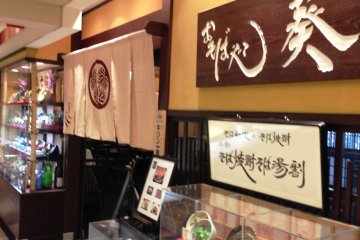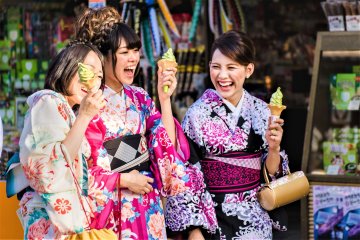“Would you like to try some salty green tea?” the chirpy shopkeeper asked. Thinking she was some kind of apothecary, I had to do a double-take.
I had associated green tea with a slightly bitter aftertaste, or maybe bittersweet in a matcha ice cream, so salty was not what I was expecting. But what I was drinking was distinctly savory, like salted nori seaweed used for sushi wraps. Indeed, after leaving the store I developed quite an appetite, so I can see how this type of tea might become addictive! Just ask Aki, who started a tea farm after discovering the delights of Japanese tea.
My tea tasting experience with a housewife tea grocer in the middle of a market hall was something you don’t find in most travel guides. There were no other tourists around, just housewives doing their daily rounds of shopping for fresh tofu and mackerel, kids playing with table soccer after school, and elderly people chatting with their grocer. Indeed, I doubt if anyone spoke much English in the suburbs between Kyoto and Osaka, but heartland Japan is incredibly friendly, and between the smiles, the accommodating gestures, and the tastings, all was well. If you want to get away from the tour buses and experience a day in the life of Mrs. Watanabe, a chance encounter like my tea-tasting can make for a memorable Japanese travel experience.
After tasting a couple of fruity, savory teas and also those with a beautiful roasted aroma, I bought three packets of the young green harvest style that more delicately balanced the bitter, green, and savory palates called Tama sou en ryoku-cha. Of course, if you want to dive in and go for the savory tea, ask for the umeboshi plum variety. At less than 500 yen for an 80-gram packet, they make a unique, inexpensive, light and easy to carry omiyage gift for someone you love, or why not spoil yourself with a souvenir? They even gift wrap the packages for free while you wait, and are open 365 days a year. It is one of the few places that is open on the New Year's Day holidays.
While sipping a cup some days later, I learned that it takes a lifetime to become a tea connoisseur. As Mr. Soseki says in his book The Three-Cornered World, “For the man of leisure there is no more refined nor delightful pursuit than savoring this thick delicious nectar, drop by drop on the tip of the tongue. The average person talks of ‘drinking’ tea, but this is a mistake. Once you have let a little of the pure liquid spread slowly over your tongue, there is scarcely any need to swallow it. It is merely a question of letting the fragrance penetrate from your throat down to your stomach.”
Many parts of Japan have their specialty teas, such as Sencha, Hōjicha Gyokuro, and Gencha, from places like Nishio in Aichi, Wazuka in Kyoto, and the hills below Aso-san in Kumamoto. Gyokoro is often called the espresso of teas, made more intense by keeping the bushes under shade just before it is harvested, resulting in a higher concentration of antioxidants and vitamins. Rich and full of unami characteristics, it reminds me of seaweed. There is a real art to steeping Gyokuro, as boiling water can spoil its taste, just like coffee. The first steeping should just cover the leaves at around 40 degrees but yield very little liquid so that it comes like drops of exquisite pearls. The sweet and vegetal taste balances each other, and while you can distinguish each taste in the third steeping, the fourth steeping has the tastes blended more closely together. It is like the tea leaves, bathed and slowly awakened by warm water, is slowly revealing its characteristics like a flower, slowly blossoming and revealing its inner beauty. Or as Mr. Soseki puts it, “Gyokuro tea escapes the insipidness of pure water and yet is not so thick as to require any tiring jaw action.” He even goes on to say that while “some complain that if they drink tea they cannot sleep, but to them, I would say that it is better to go without sleep than without tea.”
The thought of culinary delight induced by savory tea and nori brings me back to another Japanese speciality, ochazuke, the ultimate comfort food made by pouring hot tea on top of a bowl of rice, seasoned with nori and salmon flakes. It is said that in Kyoto, a host would offer ochazuke as a sign that the evening is winding up, while in Osaka, ochazuke is a sign of thrift, a way to eat well without breaking the bank.









